
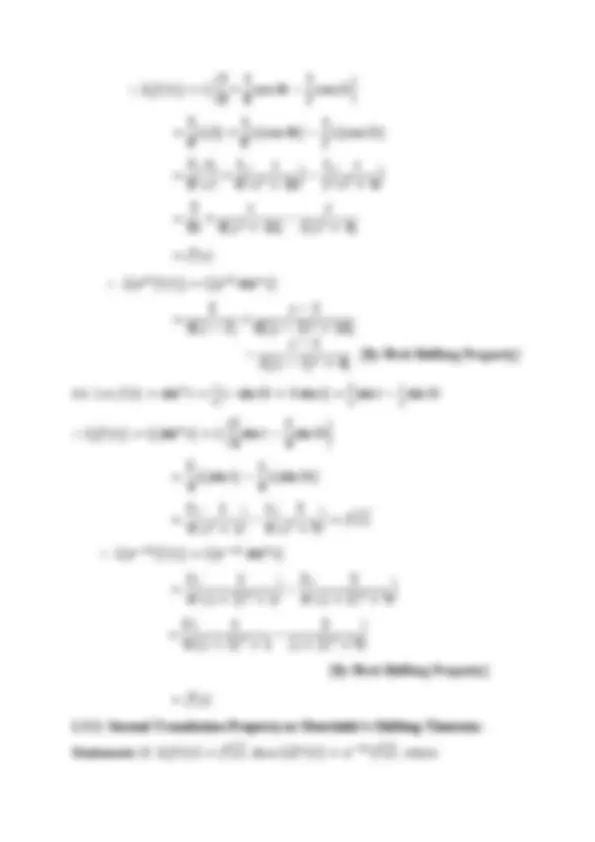
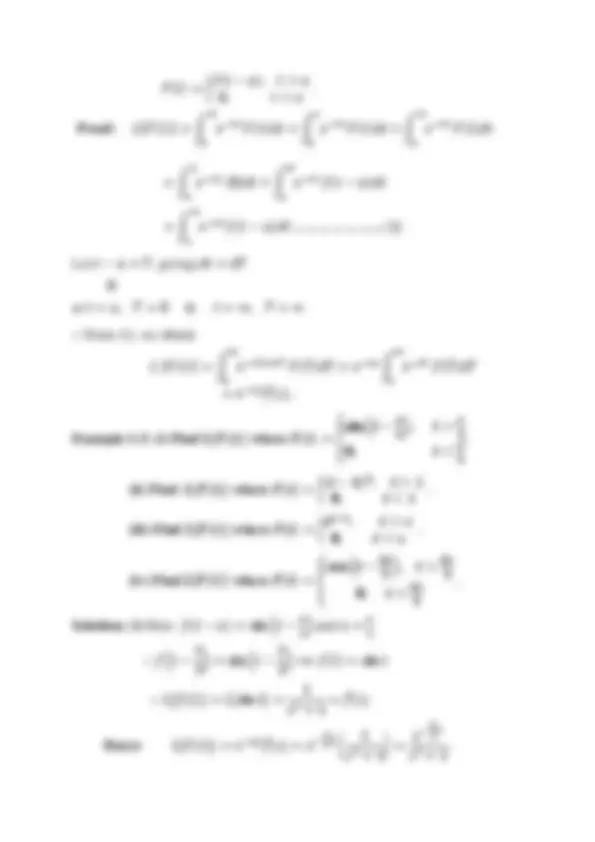
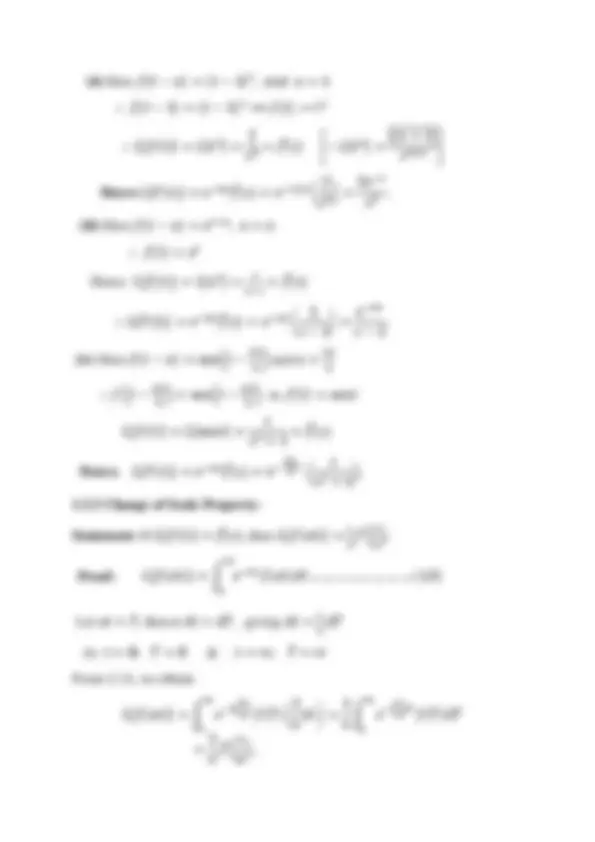
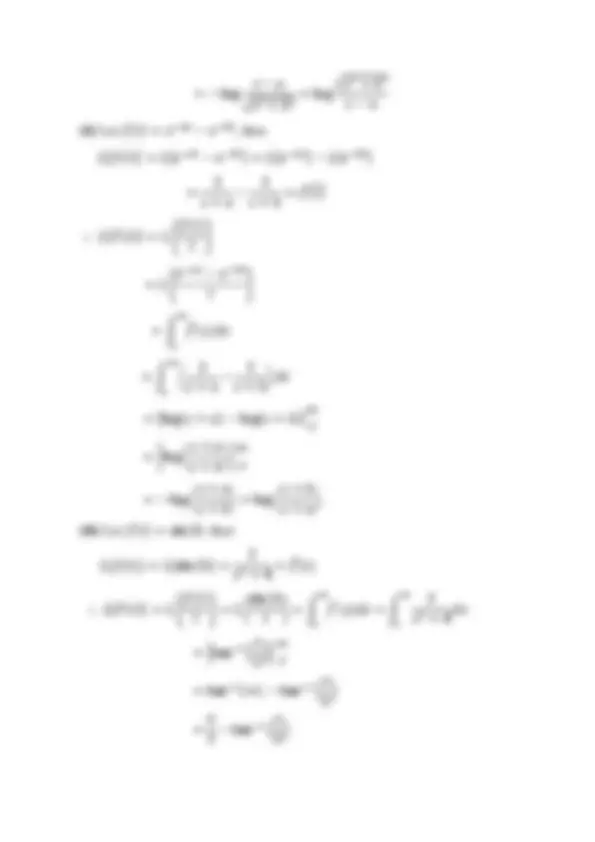
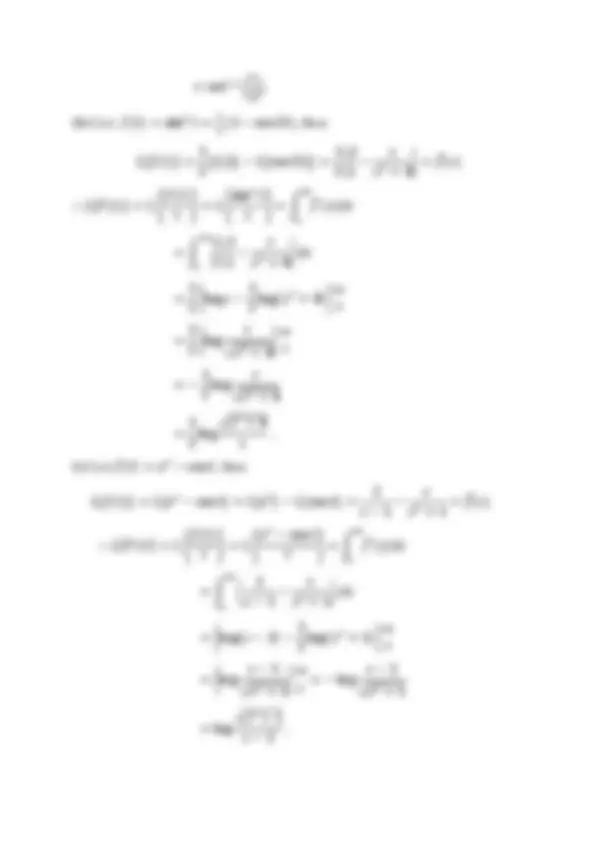
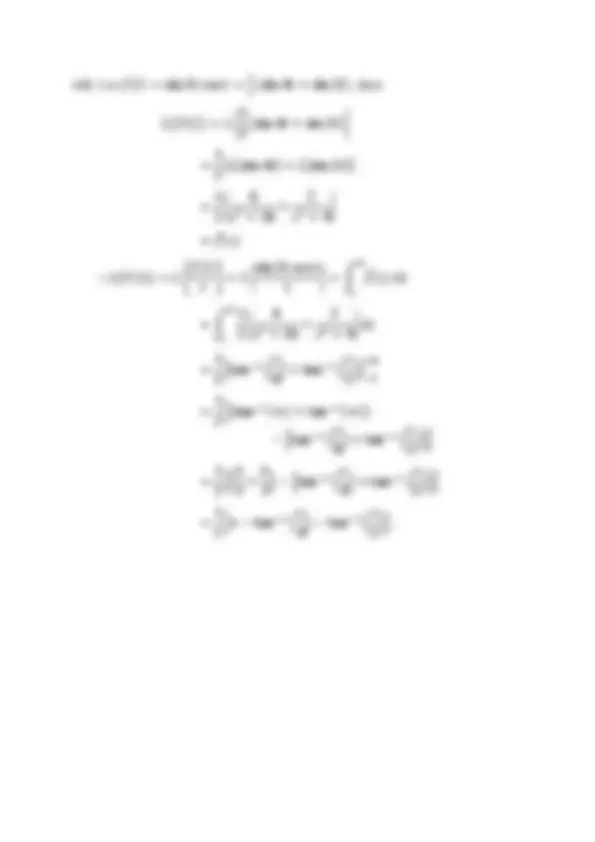


Study with the several resources on Docsity

Earn points by helping other students or get them with a premium plan


Prepare for your exams
Study with the several resources on Docsity

Earn points to download
Earn points by helping other students or get them with a premium plan
Community
Ask the community for help and clear up your study doubts
Discover the best universities in your country according to Docsity users
Free resources
Download our free guides on studying techniques, anxiety management strategies, and thesis advice from Docsity tutors
The existence and properties of Laplace transforms. It explains the conditions for the existence of Laplace transforms and provides a theorem and proof for the same. It also discusses the first translation property and provides an example to find Laplace transforms of different functions. relevant for students studying mathematics, engineering, and physics.
Typology: Summaries
1 / 10

This page cannot be seen from the preview
Don't miss anything!







1.4: Existence of Laplace Transforms
The Laplace transform of any function 𝑓(𝑡) will exist if the integral in Section
(1.1) is convergent. For the purpose, the whole integrand 𝑒
−𝑠𝑡
𝑓(𝑡) goes to zero
fast enough as 𝑡 → ∞, at least like an exponential function with a negative
exponent. This implies that 𝑓(𝑡) itself should not grow faster than, 𝑒
𝑘𝑡
This motivates the inequality (1.2) given in the following theorem:
Theorem 1.1: Let 𝑓(𝑡) be a function that is piecewise continuous on every finite
interval in the range 𝑡 ≥ 0 and satisfies
𝑘𝑡
for all 𝑡 ≧ 0 , … … … … … … … … … … ( 1. 2 )
and for some constants 𝑘 and 𝑀. Then the Laplace transform of 𝑓(𝑡) exists
for all 𝑠 > 𝑘.
Proof: Since 𝑓(𝑡) is continuous, the integrand 𝑒
−𝑠𝑡
𝑓(𝑡) is integrable over any
finite interval on the t-axis.
From (1.2), assuming that 𝑠 > 𝑘, we obtain
−𝑠𝑡
∞
0
∞
0
−𝑠𝑡
∞
0
𝑘𝑡
−𝑠𝑡
where the condition 𝑠 > 𝑘 was needed for the existence of the last integral.
This completes the proof of the theorem.
1.5: Properties of Laplace Transform
1.5.1: First Translation Property or First Shifting Property
Statement: If 𝐿
(𝑠), then 𝐿
−𝑎𝑡
Proof: 𝐿{𝑒
−𝑎𝑡
−𝑠𝑡
∞
0
−𝑎𝑡
−
( 𝑠+𝑎
)
∞
0
Corollary: If 𝐿{𝑓(𝑡)} = 𝑓
(𝑠), then 𝐿{𝑒
𝑎𝑡
Example 1.2: Find the Laplace Transforms of
(i) (𝟏 + 𝒕 𝒆
−𝒕
𝟑
(ii) 𝒆
−𝟑𝒕
(𝐜𝐨𝐬 𝟒𝒕 + 𝟑 𝐬𝐢𝐧 𝟒𝒕) (iii) 𝒆
−𝒕
𝟐
(iv) 𝒆
𝟐𝒕
𝟒
𝒕 (v) 𝒆
−𝟐𝒕
𝟑
Solution: (i) Let 𝑓(𝑡) = ( 1 + 𝑡 𝑒
−𝑡
3
− 3 𝑡
3
−𝑡
− 2 𝑡
2
−𝑡
3
− 3 𝑡
3
−𝑡
− 2 𝑡
2
− 3 𝑡
3
−𝑡
− 2 𝑡
2
4
2
3
4
2
3
(ii) Let 𝑓
− 3 𝑡
cos 4 𝑡 + 3 sin 4 𝑡
− 3 𝑡
cos 4 𝑡 + 3 𝑒
− 3 𝑡
sin 4 𝑡
− 3 𝑡
− 3 𝑡
cos 4 𝑡 + 3 𝑒
− 3 𝑡
sin 4 𝑡}
− 3 𝑡
cos 4 𝑡
− 3 𝑡
sin 4 𝑡}
2
2
2
2
(iii) Let 𝑓
−𝑡
sin
2
𝑒
−𝑡
2
1 − cos 2 𝑡
−𝑡
−𝑡
cos 2 𝑡]
−𝑎𝑡
−𝑡
−𝑡
cos 2 𝑡}]
2
(iv) Let 𝑓
= sin
4
3
8
1
8
cos 4 𝑡 −
1
2
cos 2 𝑡
Proof: 𝐿
−𝑠𝑡
∞
0
−𝑠𝑡
𝑎
0
−𝑠𝑡
∞
𝑎
−𝑠𝑡
𝑎
0
−𝑠𝑡
∞
𝑎
−𝑠𝑡
∞
𝑎
Let 𝑡 − 𝑎 = 𝑇, giving 𝑑𝑡 = 𝑑𝑇
at 𝑡 = 𝑎, 𝑇 = 0 & 𝑡 = ∞, 𝑇 = ∞
∴ From (1), we obtain
−𝑠
( 𝑎+𝑇
)
∞
0
−𝑎𝑠
−𝑠𝑇
∞
0
−𝑎𝑠
Example 1.3: (i) Find 𝑳{𝑭(𝒕)} where 𝑭(𝒕) = {
𝝅
𝟑
𝝅
𝟑
𝝅
𝟑
(ii) Find 𝑳{𝑭(𝒕)} where 𝑭(𝒕) = {
𝟐
(iii) Find 𝑳{𝑭(𝒕)} where 𝑭(𝒕) = {
𝒕−𝒂
(iv) Find 𝑳
where 𝑭
𝟐𝝅
𝟑
𝟐𝝅
𝟑
𝟐𝝅
𝟑
Solution: (i) Here 𝑓(𝑡 − 𝑎) = sin (𝑡 −
𝜋
3
) and 𝑎 =
𝜋
3
) = sin (𝑡 −
= sin 𝑡
∴ 𝐿{𝑓(𝑡)} = 𝐿{sin 𝑡} =
2
Hence 𝐿{𝐹(𝑡)} = 𝑒
−𝑎𝑠
−
𝜋
3
𝑠
2
−
𝜋
3
𝑠
2
(ii) Here 𝑓
2
2
2
2
3
𝑛
𝑛+ 1
Hence 𝐿{𝐹(𝑡)} = 𝑒
−𝑎𝑠
−( 1 )𝑠
3
−𝑠
3
(iii) Here 𝑓(𝑡 − 𝑎) = 𝑒
𝑡−𝑎
𝑡
Hence 𝐿{𝑓(𝑡)} = 𝐿{𝑒
𝑡
1
𝑠− 1
−𝑎𝑠
−𝑎𝑠
−𝑎𝑠
(iv) Here 𝑓
= cos (𝑡 −
2 𝜋
3
) and 𝑎 =
2 𝜋
3
2 𝜋
3
) = cos (𝑡 −
2 𝜋
3
) or, 𝑓
= cos 𝑡
cos 𝑡
2
Hence, 𝐿{𝐹(𝑡)} = 𝑒
−𝑎𝑠
−
2 𝜋
3
𝑠
2
1.5.3 Change of Scale Property:
Statement: If 𝐿
(𝑠), then 𝐿
1
𝑎
𝑠
𝑎
Proof:
−𝑠𝑡
∞
0
Let 𝑎𝑡 = 𝑇, then 𝑎 𝑑𝑡 = 𝑑𝑇, giving 𝑑𝑡 =
1
𝑎
At 𝑡 = 0 : 𝑇 = 0 & 𝑡 = ∞: 𝑇 = ∞
From (1.3), we obtain
−𝑠(
𝑇
𝑎
)
∞
0
−(
𝑠
𝑎
)𝑇
∞
0
∞
0
−𝑠𝑡
∞
𝑠
after changing the order of integration.
∞
0
−𝑠𝑡
∞
0
−𝑠𝑡
−𝑠𝑡
∞
0
Example 1.5: Find the Laplace Transform of 𝑭(𝒕) , where (i) 𝑭(𝒕) =
𝒆
𝒂𝒕
−𝐜𝐨𝐬 𝒃𝒕
𝒕
(ii) 𝑭
𝒆
−𝒂𝒕
−𝒆
−𝒃𝒕
𝒕
(iii) 𝑭
𝐬𝐢𝐧 𝟐𝒕
𝒕
(iv) 𝑭
𝐬𝐢𝐧
𝟐
𝒕
𝒕
(v) 𝑭
𝒆
𝒕
−𝐜𝐨𝐬 𝒕
𝒕
(vi) 𝑭
𝐬𝐢𝐧 𝟑𝒕 𝐜𝐨𝐬 𝒕
𝒕
Solution: (i) Let 𝑓(𝑡) = 𝑒
𝑎𝑡
− cos 𝑏𝑡, then
𝑎𝑡
− cos 𝑏𝑡
𝑎𝑡
cos 𝑏𝑡
1
𝑠−𝑎
𝑠
𝑠
2
+𝑏
2
𝑎𝑡
− cos 𝑏𝑡
∞
𝑠
2
2
∞
𝑠
= [log
log
2
2
= [log
2
2
= − log
2
2
= log
2
2
(ii) Let 𝑓
−𝑎𝑡
−𝑏𝑡
, then
−𝑎𝑡
−𝑏𝑡
−𝑎𝑡
−𝑏𝑡
−𝑎𝑡
−𝑏𝑡
∞
𝑠
∞
𝑠
log
− log
= [log (
= − log (
) = log (
(iii) Let 𝑓
= sin 2 𝑡, then
𝐿{𝑓(𝑡)} = 𝐿{sin 2 𝑡} =
2
sin 2 𝑡
∞
𝑠
2
∞
𝑠
= [tan
− 1
= tan
− 1
(∞) − tan
− 1
− tan
− 1
(vi) Let 𝑓
= sin 3 𝑡 cos 𝑡 =
1
2
sin 4 𝑡 + sin 2 𝑡
, then
sin 4 𝑡 + sin 2 𝑡
sin 4 𝑡
sin 2 𝑡
2
2
sin 3 𝑡 cos 𝑡
∞
𝑠
∞
𝑠
2
2
[tan
− 1
) + tan
− 1
tan
− 1
− 1
− {tan
− 1
) + tan
− 1
} − {tan
− 1
) + tan
− 1
[𝜋 − tan
− 1
) − tan
− 1